If your circuit is mainly as described with no electronics in the middle then you definitely need a diode. What you then have is effectively an alternator with diode rectification. Voltage generated needs to be greater than battery voltage + a diode drop.
If your system applies a magnetic pulse to the coil and then removes the field rapidly you may be able to get an inductive "kick" of much greater voltage than was generated by the magnet directly.
If your generated voltage is less or much less than the battery voltage then you will need a circuit to step this up to battery voltage. There are a range of "energy harvesting" ICs available from various manufacturers that perform this function.
LT overview very nice introduction to their products in a range of energy harvesting areas.
LT DN491
Discusses LTC3105. Shows use of 2 cell = 1 V PV panel BUT this would work with inductive input.
LT DN428
Demonstrates LTC3526 boost converter.
They are using it from a single cell but again would work with inductive input.
LT Journal uses LTC3108 & LTC3109 at very low Vin. RTEG in this case, but ... .
LTC3588 piezo in
Magazine article useful.
SOLAR relevant but not directly applicable
MAX17710 Energy-Harvesting Charger and Protector
TI BQ25504
Datasheet potentially useful
Ideas galore
ADDED:
@Rex - did you look at the app notes. Some make it easy enough.
BUT if you substitute a capacitor for the battery you can get a good idea of what is happening. A common DMM (digital multimeter) a coil, a diode and a magnet and a say 10 megohm resistor across the capacitor when wanted, should be about enough.

simulate this circuit – Schematic created using CircuitLab
A small capacitor (100 pF to say 10 nF range) should charge with ease. As cap gets bigger charging may take multiple magnet swipes. Placing the resistor across the cap will discharge it in time. 10M and 1uF ceramic or Tantalum cap will discharge to ABOUT 60% in 10 seconds. Smaller caps faster.
